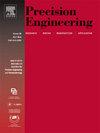Smooth trajectory generation and hybrid B-splines-quaternions based tool path interpolation for a 3T1R parallel kinematic milling robot
IF 3.5
2区 工程技术
Q2 ENGINEERING, MANUFACTURING
Precision Engineering-Journal of the International Societies for Precision Engineering and Nanotechnology
Pub Date : 2025-04-21
DOI:10.1016/j.precisioneng.2025.04.020
引用次数: 0
Abstract
This paper presents a smooth trajectory generation method for a four-degree-of-freedom parallel kinematic milling robot. The proposed approach integrates B-spline and Quaternion interpolation techniques to manage decoupled position and orientation data points. The synchronization of orientation and arc-length-parameterized position data is achieved through the fitting of smooth piece-wise Bezier curves, which describe the non-linear relationship between path length and tool orientation, solved via sequential quadratic programming. By leveraging the convex hull properties of Bezier curves, the method ensures spatial and temporal separation constraints for multi-agent trajectory generation. Unit quaternions are employed for orientation interpolation, providing a robust and efficient representation that avoids gimbal lock and facilitates smooth, continuous rotation. Modifier polynomials are used for position interpolation. Temporal trajectories are optimized using minimum jerk, time-optimal piece-wise Bezier curves in two stages: task space followed by joint space, implemented on a low-cost microcontroller. Experimental results demonstrate that the proposed method offers enhanced accuracy, reduced velocity fluctuations, and computational efficiency compared to conventional interpolation methods.

3T1R并联铣削机器人的光滑轨迹生成及基于b样条-四元数混合的刀具轨迹插值
本文介绍了四自由度并联运动学铣削机器人的平滑轨迹生成方法。所提出的方法集成了 B 样条插值和四元数插值技术,以管理解耦的位置和方向数据点。方位和弧长参数化位置数据的同步是通过平滑的片断贝塞尔曲线拟合实现的,该曲线描述了路径长度和刀具方位之间的非线性关系,并通过顺序二次编程求解。利用贝塞尔曲线的凸壳特性,该方法可确保多代理轨迹生成的空间和时间分离约束。采用单位四元数进行方位插值,提供了一种稳健高效的表示方法,可避免万向节锁定,并促进平滑、连续的旋转。修正多项式用于位置插值。在任务空间和关节空间两个阶段中,使用最小颠簸、时间最优的分段贝塞尔曲线对时间轨迹进行优化,并在低成本微控制器上实现。实验结果表明,与传统的插值方法相比,所提出的方法精度更高、速度波动更小、计算效率更高。
本文章由计算机程序翻译,如有差异,请以英文原文为准。
求助全文
约1分钟内获得全文
求助全文
来源期刊
CiteScore
7.40
自引率
5.60%
发文量
177
审稿时长
46 days
期刊介绍:
Precision Engineering - Journal of the International Societies for Precision Engineering and Nanotechnology is devoted to the multidisciplinary study and practice of high accuracy engineering, metrology, and manufacturing. The journal takes an integrated approach to all subjects related to research, design, manufacture, performance validation, and application of high precision machines, instruments, and components, including fundamental and applied research and development in manufacturing processes, fabrication technology, and advanced measurement science. The scope includes precision-engineered systems and supporting metrology over the full range of length scales, from atom-based nanotechnology and advanced lithographic technology to large-scale systems, including optical and radio telescopes and macrometrology.

 求助内容:
求助内容: 应助结果提醒方式:
应助结果提醒方式:


